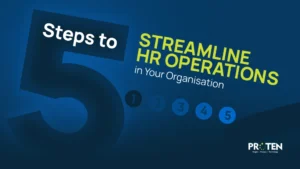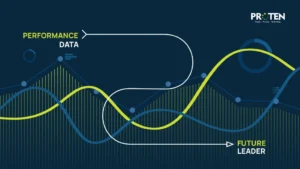As we step into the second half of the year, performance reviews are taking centre stage. Teams are assessing progress, realigning on goals, and preparing for conversations meant to spark growth and sharpen focus. But here’s the catch: even with the best intentions, performance management mistakes are still possible.
A striking Gallup study reveals that only 26% of employees strongly agree that the feedback they receive actually helps them improve. This disconnect between what performance reviews are meant to do and how they’re experienced is more than a missed opportunity; it’s a direct threat to engagement, productivity, and retention.
The problem isn’t that leaders don’t care. It’s that performance reviews often become too focused on ticking boxes and following the structure, while losing sight of what matters, which is honest, actionable, and personalized feedback that helps people grow.
To help you steer clear of that trap in your next appraisal cycle, here are 10 common performance management mistakes to avoid, along with practical ways to turn your reviews into powerful tools for clarity, development, and meaningful connection.
1. Treating Feedback as a Formality, Not a Practice
A mid-year review shouldn’t be the first time an employee hears meaningful feedback, and yet, for many, it is.
Too often, we treat feedback as a scheduled event instead of an ongoing conversation. We wait until June or July to surface concerns, deliver praise, or adjust expectations, even though the work has been evolving daily.
This approach tends to result in one of two things: vague encouragement (“you’re doing well, just keep it up”) or retroactive criticism that lands without context or support.
The better alternative? Normalize regular, informal feedback loops. Use the mid-year review as an opportunity to deepen the narrative, not introduce it. When feedback becomes part of everyday culture, reviews feel like a natural continuation, not a surprise.
2. Focusing on Goals Without Updating the Context
Every HR professional has seen the goals set in January, then reviewed in July with the same metrics every single time, despite dramatic shifts in business direction, team structures, or market conditions.
We hold employees accountable to static expectations, even when the ground beneath them has moved.
Mid-year reviews aren’t just about measuring progress, they’re about re-evaluating relevance. Are the goals still meaningful? Do they help the employee grow? And are they still tied to team outcomes and business priorities?
If not, you’re not managing performance, you’re just grading persistence.
One of the most important shifts you can make is moving from rigid accountability to agile alignment. Recalibrate where needed. Celebrate the pivot as much as the progress.
3. Overlooking Emotional Cues and Team Dynamics
There’s a dangerous assumption that performance can be assessed in a vacuum, disconnected from well-being, relationships, or psychological safety.
But we’re managing people, not output streams.
Take a step back and consider what mid-year reviews really capture: not just what’s been done, but how people have been doing. Are they thriving, or merely coping? Are they leaning in or quietly disengaging?
Burnout doesn’t always show up in metrics. Disconnection doesn’t always look like underperformance. That’s why performance management must include emotional intelligence, not just data points.
Here’s a noteworthy example: a high-performing employee with perfect metrics may still be on the verge of leaving if they feel unseen or unsupported. If your review process doesn’t uncover that reality, it’s failing both the individual and the business.
4. Conducting One-Way Conversations
Performance reviews should be two-way conversations. Yet, too many mid-year check-ins become monologues: the manager talks, the employee listens, and that’s the end of it. This dynamic creates silence where there should be insight.
Instead of this, invite employees to share their side of the story: What do they need more of? Where do they feel they’re growing or stuck? What barriers are holding them back?
A manager’s role in performance management is not just to evaluate, but also to understand. And understanding starts with asking better questions and creating space for unfiltered answers.
If a performance conversation feels too neat, then it’s probably not complete.
5. Measuring Only What’s Easy to Quantify
Many mid-year reviews are overly reliant on numbers, output, timeliness, and efficiency. While these are great qualities to look out for, performance isn’t just about what someone achieves, it’s also about how they contribute.
Are they mentoring others? Elevating the team culture? Navigating complex problems with creativity? Holding the line when things get difficult?
You need to start recognizing and rewarding invisible labor, like the emotional, relational, and strategic work that often goes unnoticed but is essential to team cohesion and innovation.
It’s harder to measure, yes, but it’s also what sets high-performing teams apart from functional ones.
6. Ignoring Underperformance Until It Becomes a Crisis
One of the most damaging performance management mistakes is waiting until problems are undeniable before addressing them. Managers often avoid tough conversations under the guise of being “nice” or “protective,” but silence only delays support.
By the time underperformance is documented, it’s often entrenched and much harder to reverse. Instead, foster a proactive, coaching-centered environment where early signals trigger honest conversations and realignment. Underperformance should not be taken as a verdict, but rather a signal for deeper inquiry.
7. Giving Everyone the Same Review Template
Standardized templates may create consistency, but they can also flatten nuance. A one-size-fits-all review framework often forces managers to reduce complex performance into checkboxes, stripping out what makes each employee unique.
Effective performance management tailors feedback to the role, context, and individual. Personalization isn’t a luxury, it’s a necessity for motivation and growth. The right format should empower meaningful dialogue, not stifle it.
8. Centering the Conversation on Past Performance Only
Mid-year reviews often read like history lessons, focused solely on what’s already happened. But performance management isn’t about looking backward, it’s about propelling people forward.
Yes, past performance matters, but it should be used as a launching pad to explore future potential, skill development, and career goals. Build the bridge between what was and what could be.
9. Forgetting That Managers Need Support Too
We expect managers to lead performance reviews with confidence and clarity, but how often do we equip them to do so? Most receive little to no training on how to have effective, empathetic, feedback-rich conversations.
One of the biggest overlooked risks in performance reviews is skipping manager enablement. Without equipping your managers to lead effective, growth-focused conversations, both employees and managers walk away disappointed.
10. Leaving Values Out of the Conversation
Values often sit in the employee handbook or on a website, but rarely make it into performance reviews. That’s a missed opportunity. When people are evaluated only on tasks, they begin to treat work like a transaction.
Reinforcing company values during performance conversations helps employees see how their behavior and choices contribute to the culture. This creates alignment beyond metrics—it builds purpose.
A Shift in Perspective: How to Avoid Performance Management Mistakes.
If we’re being honest, many performance review processes are designed for compliance. They’re meant to tick a box, generate a rating, and justify compensation decisions. However, people don’t grow in systems, they grow in relationships. And relationships thrive when there is trust, clarity, feedback, and care. That’s what mid-year performance management should strive to cultivate.
So if you want better outcomes, you need to ask better questions:
- Are you making space for honest, two-way dialogue?
- Are you adjusting goals to match the present, not the past?
- Are you acknowledging emotional and invisible contributions?
- Are you helping people connect their work to purpose and growth?
These aren’t easy shifts, but they are necessary ones.
Final Thoughts…
Mid-year performance reviews are a mirror to reflect the state of your culture, your leadership, and your people strategy. So here’s the question worth pausing over: What does your current approach to performance management say about what you truly value?
If it’s not fostering clarity, connection, and growth, it may be time for a reset, because performance management, done right, doesn’t just assess the past; it shapes the future.
Looking ahead to Q3, the real opportunity lies not just in avoiding performance management mistakes but in using this moment to align your team with a sharper focus and shared purpose.
If you’re curious about how to turn your mid-year appraisals into a strategic alignment tool, and not just a formality, check out our blog on How to Align Your Team for Success Before Q3 with Mid-Year Performance Appraisals. It’s filled with strategies you need to make the second half of the year not just productive, but transformative. And check out 100 thought-provoking, boundary-pushing, growth-driving questions that will reshape your performance reviews.










